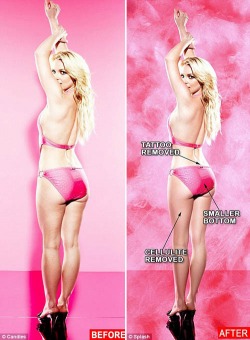 Britney Spears It’s not often (ever?!) that I am heard uttering the words “Good on you Britney”, but today, I think Britney Spears has done good. She agreed to let the UK's Daily Mail release un-airbrushed images of herself next to the digitally-altered versions. They say "the 29-year-old singer made the extraordinary move in order to highlight the pressure exerted on women to look perfect". I spent some time looking at these photos, comparing the 'before' and 'after' shots and am amazed at how extensively every blemish and "not perfect" aspect is corrected. The dry skin is covered, the bruises are banished. Even Brit's muscles have been smoothed over and 'minimised', and the *ahem* 'camel toe' dealt to. With glossy magazines and bill boards taunting women with impossible beauty it is great to actually see the full extent of how we are being deceived by the use of digital enhancement. On a conscious level, I know that most magazine and advertisements featuring scantily clad women are airbrushed. On a subconscious level, I still find myself marvelling at the petite bottoms, incredibly long legs and flawless bellies. I am long past aiming for such “flawless perfection” and have even come to love my belly that always has and always will have a slightly-pregnant pose to it. But as a teenager facing these billboards and glossy pictures, I remember having such a distorted view of my body. At 14, I went bikini shopping and spent hours in front of shop mirrors in countless numbers of size 8 bikinis grabbing every piece of “fat” (read: skin fold), only to finally conclude that I was definitely too fat to wear a bikini and went home empty handed. It makes me sad to think that I, age 14, incredibly fit and swim training up to 16 hours a week, was so sucked in by the media portrayal of ‘beauty’ to think of myself as too fat to wear a bikini. (But it also makes me smile when I throw on my a-few-sizes-bigger-than-an-8 bikini now!) My heart goes out to the girls growing up now, in a society so much more saturated by mass media and commercialism than it was in my childhood. Countless studies have shown a direct link between the media’s portrayal of beauty and body image disorders such as bulimia and anorexia. These disorders are increasing at a disturbing rate. We need to get real about the unrealistic images of “beauty” that are so prevalent in the media. So I thank you Britney for showing the world that in fact you do have dimply thighs. You don’t have a concave belly or shiny skin and you even get bruises on your legs like the rest of us. I hope more celeb’s follow suit. In fact, I hope this starts the tide of people demanding that we see REAL people in our magazines and advertisements. Getting rid of digital enhancement is an unrealistic request, but what I want to see alongside all future airbrushed images is a statement like this: “This woman’s body has been digitally enhanced. She really has dimply thighs, a cute sticky-outy belly and a small scar on her knee, but we were worried you wouldn’t buy our product if you saw those humanising features”
1 Comment
Louise
14/4/2010 03:39:41 pm
Great article Rach - could not agree more. I love the suggested disclaimer that you would like supporting every piece of digitally enhanced imagery (made me laugh too)! I too have been that person in that changing room in that bikini!
Reply
Your comment will be posted after it is approved.
Leave a Reply. |
AuthorRachel is a writer and educator whose fields of interest include sexuality education, gender, feminism and youth development. Archives
November 2023
Categories
All
|


 RSS Feed
RSS Feed




